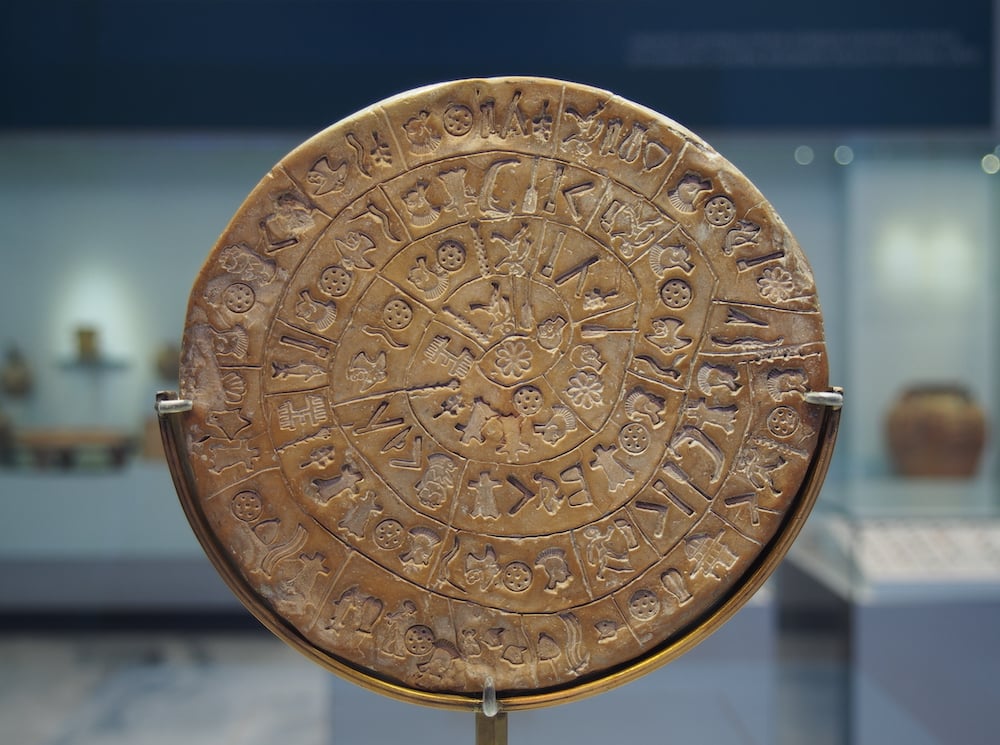
The Phaistos Disc, discovered in 1908 in Crete, has long been a subject of intrigue due to its undeciphered symbols arranged in a spiral pattern. Over the years, numerous scholars have attempted to interpret its meaning.
Notably, linguist Dr. Gareth Owens, who has dedicated over three decades to studying the disc, claimed in 2024 to have deciphered 99 percent of its content, suggesting it is a prayer to a mother goddess. T
The Minoan goddess of love, Astarte, who is linked to the Eastern goddess Ashtart, is the key figure that unlocks the mystery of the Phaistos Disc, Owens argues.
The Phaistos Disc is a disk of fired clay from the Minoan palace of Phaistos on the island of Crete, possibly dating to the middle or late Minoan Bronze Age (second millennium B.C.).
Phaistos Disc: one of archaeology’s greatest mysteries
The disk is about 15 cm (5.9 in) in diameter and covered on both sides with a spiral of stamped symbols.
The language imprinted on the face of the mysterious disk has never been fully decoded, and its symbols are part of no known alphabet either ancient or modern.
Some symbols, however, bear a resemblance to those found in Linear A and Linear B, which were the ancient languages of the Minoans. Linear A has not yet been decoded.
Others are similar to hieroglyphs found in ancient Anatolian sites.
Although the vast majority of scholars believe that the Phaistos Disc is authentic, a few archaeologists are unconvinced of its authenticity.
Its purpose and meaning, and even its original geographical place of manufacture, remain disputed, making it one of the most famous mysteries of archaeology.
This unique object is now on display at the Archaeological Museum of Heraklion.
Is the goddess of love the key to decoding the disk?
Owens says: “We are reading the Phaistos disc with the vocal values of Linear B and with the help of comparative linguistics, i.e. comparing with other relative languages from the Indo-European language family. Reading something, however, does not mean understanding.”
According to his data, the disc is a religious text to a “pregnant goddess” that takes shape in the face of Astarte, the goddess of love.
“There is no doubt that we are talking about a religious text,” Owens reveals. “This is clear from a comparison made with other religious words from other inscriptions from the holy mountains of Crete. We have words that are exactly the same.”
The scholar adds that he suspects that “the Phaistos Disc is a hymn before Astarte, the goddess of love. Words such as those mentioned on the disc have been found on Minoan offerings.”
“As with today’s offerings, people pray when they are troubled, because of health problems or personal reasons,” he says. “Man doesn’t change, after all.”
The archaeologist says he believes that one side of the Phaistos Disc is dedicated to a pregnant mother goddess while the other is dedicated to the Minoan goddess Astarte.
On the importance of the figure, Owens noted that Minoan Astarte was the goddess of love, war, and the mountains and that her origin lies in the east. The goddess’s roots are “from ancient Mesopotamia, located in today’s Turkey; Astarte went to Cyprus and became Venus,” he explained.
Despite such claims, the broader academic community remains cautious. The unique nature of the disc, combined with the absence of additional similar artifacts, makes definitive verification challenging. As a result, while intriguing theories exist, the mystery of the Phaistos Disc’s true meaning continues to be a topic of debate and research.